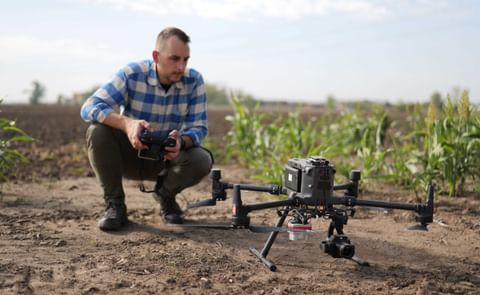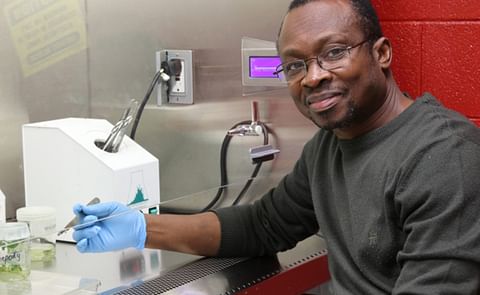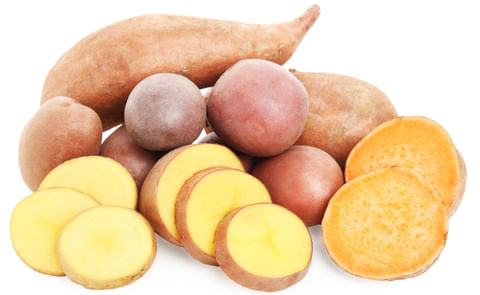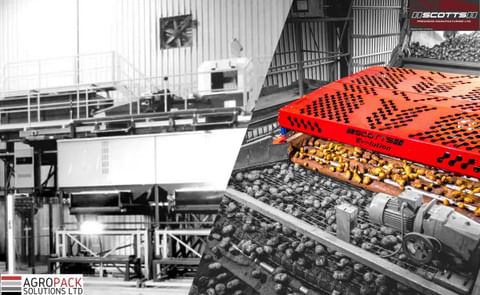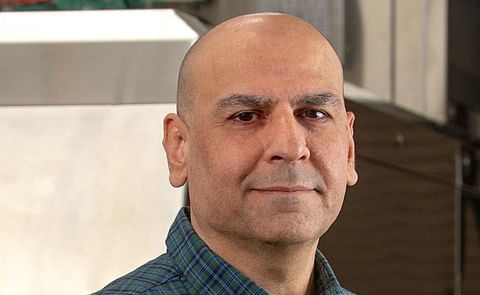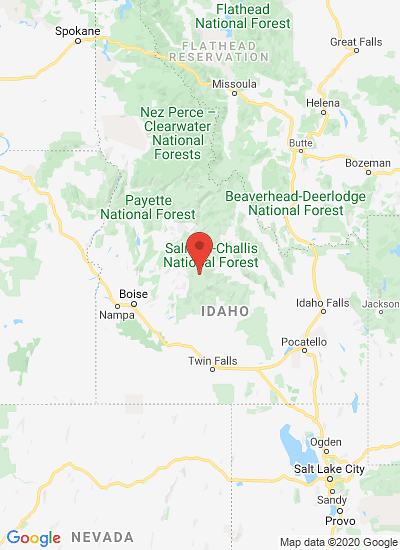Ongoing research in Idaho targets PVY in search of solutions. (Courtesy: Jonathan Whitworth of the USDA)
Ongoing research in Idaho targets PVY in search of solutions

Ongoing studies at the University of Idaho’s Aberdeen Research & Extension Center seek to help seed potato growers avoid a chronically troublesome disease spread by aphids, called potato virus Y, writes John O’Connell in the Idaho State Journal.
He writes one UI research project aims to better understand the importance of when aphid migrations occur and how that correlates with the severity of disease transmission.
Another project will attempt to establish a connection between the temperature and aphid migrations. A third project is studying how covering the space between potato rows with straw mulch or spraying foliage with mineral oil may deter aphids from probing spud plants. UI potato breeders are also involved in the effort of developing new potato varieties with resistance to PVY strains.
Kasia Duellman, UI Extension seed potato specialist:
Duellman is leading research in Aberdeen that entails covering potato rows at different periods throughout the year to keep insects out and removing covers after vines are killed at the season's end.
The project also entails setting out yellow buckets, each containing a little copper sulfate and a drop of dish soap, to attract and capture aphids. Researchers will be monitoring a network of about 30 buckets, with help from industry agronomists. UI research technician Jill Randall will be helping entomologists Eric Wenninger and Andy Jensen to count aphids from the buckets and determine the types.
Duellman said Idaho Crop Improvement Association has been operating an aphid monitoring network for several years, but UI got involved this year to expand it and make it more meaningful.
UI researchers Alex Karasev, who is a plant virologist, and Nora Olsen, who is a potato storage expert, are assisting Wenninger in studying how hot temperatures may affect aphid migration. The research could potentially provide growers a predictive tool to aid in management decisions.
Jonathan Whitworth, a research plant pathologist with USDA's Agricultural Research Service who works closely with UI, said the university's breeding program has been working to breed PVY resistance genes into its germplasm. He said the program is working to convince potato processors to use the PVY-resistant spud variety Payette Russet, and another resistant line is in the pipeline to become a variety.
Whitworth is involved in other research to prevent aphids from feeding on potato plants and spreading PVY. In some research plots, straw mulch covers the ground between potato rows. Whitworth explained aphids seem to prefer to land on bare soil. In other rows, mineral oil has been sprayed on foliage, which also seems to irritate aphids. Some rows have combinations of the techniques.
Potato leaves will be tested for the virus to see how well the trials worked. Whitworth said the methods reduced PVY infections by as much as 20 percent in preliminary testing in Kimberly.
He writes one UI research project aims to better understand the importance of when aphid migrations occur and how that correlates with the severity of disease transmission.
Another project will attempt to establish a connection between the temperature and aphid migrations. A third project is studying how covering the space between potato rows with straw mulch or spraying foliage with mineral oil may deter aphids from probing spud plants. UI potato breeders are also involved in the effort of developing new potato varieties with resistance to PVY strains.
Kasia Duellman, UI Extension seed potato specialist:
“For some reason we’re just not able to nail that coffin (on PVY), and it’s been a chronic problem for decades, but more recently, it’s been a struggle across the country.”Duellman explained another disease spread by aphids, called potato leafroll virus, used to be a significant problem in the state, but it’s since been effectively controlled with insecticides. Unlike leafroll, which is spread by colonizing aphids, PVY is spread by migratory aphids that may feed on a plant while passing through, making it tougher to prevent transmission with insecticides.
“One of the things we want to look at is when is movement of PVY most important for a seed potato grower? — in the early part of the season? at the end of the season? — and when are aphids that can move the virus likely to be moving the virus? and when is that movement most important?”
“Our job is to find out how many aphids are coming and when they're peaking.”
Duellman is leading research in Aberdeen that entails covering potato rows at different periods throughout the year to keep insects out and removing covers after vines are killed at the season's end.
The project also entails setting out yellow buckets, each containing a little copper sulfate and a drop of dish soap, to attract and capture aphids. Researchers will be monitoring a network of about 30 buckets, with help from industry agronomists. UI research technician Jill Randall will be helping entomologists Eric Wenninger and Andy Jensen to count aphids from the buckets and determine the types.
Duellman said Idaho Crop Improvement Association has been operating an aphid monitoring network for several years, but UI got involved this year to expand it and make it more meaningful.
UI researchers Alex Karasev, who is a plant virologist, and Nora Olsen, who is a potato storage expert, are assisting Wenninger in studying how hot temperatures may affect aphid migration. The research could potentially provide growers a predictive tool to aid in management decisions.
Jonathan Whitworth, a research plant pathologist with USDA's Agricultural Research Service who works closely with UI, said the university's breeding program has been working to breed PVY resistance genes into its germplasm. He said the program is working to convince potato processors to use the PVY-resistant spud variety Payette Russet, and another resistant line is in the pipeline to become a variety.
Whitworth is involved in other research to prevent aphids from feeding on potato plants and spreading PVY. In some research plots, straw mulch covers the ground between potato rows. Whitworth explained aphids seem to prefer to land on bare soil. In other rows, mineral oil has been sprayed on foliage, which also seems to irritate aphids. Some rows have combinations of the techniques.
Potato leaves will be tested for the virus to see how well the trials worked. Whitworth said the methods reduced PVY infections by as much as 20 percent in preliminary testing in Kimberly.
Like to receive news like this by email? Join and Subscribe!
NEW! Join Our BlueSky Channel for regular updates!
精选企业
Sponsored Content
Sponsored Content
Sponsored Content
Sponsored Content
Sponsored Content



